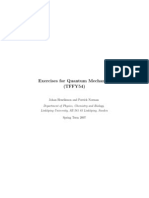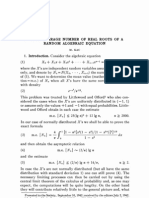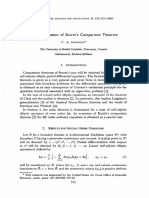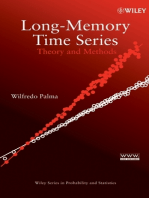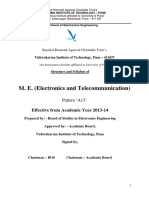Tools Matrices Operators
Uploaded by
Marwan ElmahdiTools Matrices Operators
Uploaded by
Marwan Elmahdi760
MA THEMA TICS: K. FAN
PROC. N. A. S.
always solvable uniquely for the integer y since (i) 01(Xx)/d is an integer,
(ii) X/d is prime to r/d.
Algorithmically, to apply (19.1), we may di'tide by d in those cycles of 01
which consist of multiples of d (simply omitting the other cycles, in which
none of the numerals is divisible by 1), and then multiply each numeral by
X', where (X/d)X' =- 1 (mod rld), reducing the result to its least non-negative residue mod rid.
If 0 is an exponential substitution, its derivative 01 is linear: 01(x) =,Bx
(mod r), and the condition: dj0i(dx) for all x, is obviously fulfilled. We
have for the derivative of 0' = 0X:80(x) = ,Bx (mod r/d). Hence:
THEOREM XXVII. Any power 0 of an exponential substitution 0 is a
special substitution, exponential if 1a 1 (mod r/d), linear if 13 = 1 (mod
rld), where d = (X, r).
Of course, any power of a linear substitution is linear. But the property
of the last theorem is not characteristic of exponential and linear substitutions. E.g., in the case of the following subsitution on the range 32:
0 = (0) (16) (1, 7, 9, 31, 17, 23, 25, 15) (3, 29, 27, 5, 19, 13, 11, 21)
(2, 6, 18, 22) (10, 30, 26, 14) (4, 12). (8, 24) (20, 28),
every power of 0 is special, but 0, having the derivative
01 = (0) (2) (4) (6) (1 3 5 7),
of type 3, is itself of type 4, neither exponential nor linear.
The- necessary and sufficient condition that every power e of a given
special substitution 0 be itself special is that, for every divisor d of r, the
cycle of 01 containing d shall consist entirely of multiples of d. Thi equirement is met, in particular, if r = pa, p a prime, and p is a fixed numral of
01. In the example just given, r = 23, and the numeral 2 is fixed in 01.
1 Vol. 37, nos. 9, 10 (September, October, 1951).
2
The parenthesis notation is employed for greatest common divisor.
The contrary case has already been disposed of in Note II, 13.
MAXIMUM PROPERTIES AND INEQUALITIES FOR .THE
EIGENVALUES OF COMPLETELY CONTINUOUS OPERATORS*
By KY FAN
DEPARTMENT OF MATHEMATICS, UNIVERSITY OF NOTRE DAME
Communicated by John von Neumann, September 8, 1951
1. Although several extremum properties of the eigenvalues of completely continuous (abbreviated to c. c.) operators in Hilbert space D are
know;n, nearly all of them deal with a single operator. In this respect, the
VOL. 37, 1951
MA THEMA TICS: K. FAN
761
following theorem of J. von Neumann' is of particular significance, as it involves two matrices: Let A, B be two square matrices of order n (with complex
coefficients). If { Xi }, { } are the eigenvalues2 of A *A, B*B respectively, then
E VXKis the maximum oft tr (UAVB)I, when U, V run over all unitary
IKc
matrices of order n. In the present note, Theorem 1 contains two maximum
properties (4), (5) for any finite number m of c. c. operators in Hilbert
space !. (4) is a generalization of von Neumann's theorem, while (5) is a
multiplicative companion of (4). The case m = 1 of (5) includes the important inequality of H. Weyl3 k12. . j2 < X1X2 .. . Xn (n = 1, 2, *)
between the eigenvalues { b } of a c. c. operator A in p and the eigenvalues { Xi
of A *A. The case m = 2 of (5) includes the following theorem of A. Horn4
concerning two c. c. operators A, B in ,: If Xi , { Ki }, {,/1I are the eigenvalues of A*A, B*B and (AB)*(AB), respectively, then . . . .n < X1X2 * X
XnKjK2 ... icn for n = 1, 2, .... The proof of our Theorem 1 is based on
this result of Horn and the elementary Lemma 1. Thus, in the case of
finite matrices, our proof of (4) differs from von Neumann's more geometric
proof.
For any two c. c. operators A, B in ,, inequality (10) in Theorem 2 gives
a comparison, essentially different from Horn's, of the eigenvalues of
(AB)*(AB) with those of A*A and B*B, while inequality (11) compares
the eigenvalues of (A + B)*(A + B) with those of A*A and B*B. From
(11) we derive Theorem 3 on asymptotic distribution of the eigenvalues of
(A + B)*(A + B). In the case of linear integral equations with symmetric
kernels, both (11) and Theorem 3 are well-known results of Weyl.5
As an application of the maximum property (4), we have in Theorem 5
another inequality comparing the eigenvalues of (A + B)*(A + B) with
those of A *A, B *B and involving an arbitrary symmetric gauge function.
This generalizes a result of von Neumann' concerning finite matrices. To
derive Theorem 5 from (4), we first prove Theorem 4 concerning a general
inequality for symmetric gauge functions. The geometric meaning of
Theorem 4 is clear. Analytically it is analogous to a classical theorem of
R. F. Muirhead,6 although the class of functions involved in his theorem is
entirely different from the class of symmetric gauge functions.
... > bx 2
2. LEMMA 1A. Let a, 2 a2 2 . . .> a. 0, bi
b2
0. If pij (1 < i, j < n) are n2 non-negative numbers such that
{I
Z pi < l forallj,
i=1
E pj < l forall i,
j=l
(1)
then
n
EjE p-
i=l jl
bj <
i
i t1
as b.
(2)
MA THEMA TICS: K. FAN
762
PROC. N. A. S.
Let ci 2 E pj b, (1 < i < n), For a fixed positive integer
ji
n
k
1 j n). ThenO<qj<1and qj<k. Since
k <n,letqj= p2 (1<
b, . bj+1 0, we have
Proof:
JS
k-1\
k-1
EE q.
jmi
k-1
q,)bk<
E(bJ-bk) + kbk
bj + (ki-i
i
\j
or
k
Sbi
E cj:5 ji1
ji-
(3)
(1 < k<n).
x
By Abel's lemma, ai 2 aj+j 2(0 and (3) imply E ajcj< E atbi
i-1
i=1
We shall use the above lemma in the following form:
LEMMA 1B. Let {at }, { bi } be two non-increasing infinite sequences of nonnegative numbers such that , a,bi < + . If pv (i, j = 1, 2, .. .) are noni=l
negatwe numbers such that E pt, S 1 for all j and
go
co
pq :< 1 for all i, then
co
~
i=l}l
~~
1i
THEOREM 1. Let A1, A2, .. . , Am be m (.1) c. c. operators in Hilbert
space ,. For each j = 1, 2, ., ., m, let X,j Xj2,.. ., j, . .. be the eigenvalues2
of A;Aj. Then for any positive integer n:
n1
n
Max Ejn~~~~~~~~~~
(U1A1.. UmAm xi, xi) =jj(IX1fX2. XmJ)"',2 (4)
Max
Det (U1A1.. . UmAm xi,) 2 = II
1 .i, k 5n
ijI
(NA>q
. XMi); (5)
U2, Ur independently run over all unitary
where, for both maxima, U .,
operators and { Xi, x2, .., xX } runs over all sets of n orthonormal elements in $!.
Proof: For each j = 1, 2, . . ., m, let Hj be the non-negative square root of
Ai A. Then Hi is also c. c. and its eigenvalues are VJ{ /j} . Let y1t (1 . i
< n) be n orthonormal elements in f such that Hjyji = VXyji (1 . i < n).
Let Ai = WjH1 be the polar factorization of von Neumann.7 Here Wj is a
partially isometric operator and its initial set is the closed linear manifold
determined by the range of Hj. We have then W,*A, = Hi. Since W: is
also partially isometric and its initial set is the closed linear manifold determined by the range of Aj, we can find a unitary operator Vj in such that
VAjyji = W*Ajyii = H1y,, (1 < i < n). Let Zj be a unitary operator
in t such that Zjyj. = Yj-I, i (1 < i . n), where we put yoi = ymi. Let now
763
MA THEMATICS: K. FAN
VOL. 37, 1951
Uj = Zj Vj (1 < j < m). Then U1A . ... UmAryr.n = (X12B2t . . . Xmt) /Ymt
(1< i < n). Hence, for the particular choice of Uj = Zj V, (1< j < m) and
Xi= Ym (1 < i < n), the relations
(U1A,
UmAnxi, xi)
<
... UmAmXi, Xk)
...
Det (UA
i
1i, kxn
(X1tX2t *..* j)1/2
(6)
II (X2t .. Xrn)
(7)
<
i=1
are satisfied and actually become equalities.
It remains to show that inequalities (6), (7) hold for any m unitary operators U1, . . ., Um and any n orthonormal elements xi, . . ., x. in t. We first
prove the case m = 1 of (6):
E (UA ixi, xi) < E V;.
(8)
i-1
5=1
Consider the polar factorization of A1= W1H1. Let
be a complete
orthonormal set such that H1Ylk = A/X y,. (k = 1, 2, 3, .. . Then,
since (U1A1xj, xi) = (H1xj, WU*4xj), we have
Iy I}
E
i =1
(U1A xi, xi)
OD
E E A/it (x, Y.)(YL W;U*1 Xi)
i = 1 ke1
and therefore
(U1A1x,, Xj).<
(Xi
I V
yR)
2+
i=l k=1
\ /ZL
(wiYLko lX,) 2.
AVkX. Thus (8) is
By Lemma lB, each of the last two double sums is .
:
i=l
proved.
Let now B = U1A, . .. UmAm and let
be the eigenvalues of B*B.
Since (UfA ) *(UjAj) = A4A j, repeated application of Horn's theorem gives
IKil
II
i=1
Ki <
II
i=l
(X1iX2i .
Xmf), (n
1, 2, .)
(9)
n
n
which, according to a lemma of Polya,8 implies (i V< lijX2... .Xmi) 1/2
Hence (6) will result when we apply (8) to B.
According to Lemmas 2, 3 in an earlier note9 by the author, we have for
any n orthonormal elements xl, x2, .. ., xx:
Det (Bxi, Xk) 2 < Det (B*Bxi,
kds
l (7 i,
wci, k<n 9
which, together with (9), yields (7).
Xk) <
II Ki,
764
MA THEMA TICS: K. FAN
PROC. N. A. S.
3. THEOREM 2. Let A, B be two c. c. operators in Sg. If {xj, {Ki},
{ }, o I} are the eigenvalues of A *A, B*B, (AB)*(AB), (A + B) *(A + B),
respectively, then for any two non-negative integers m, n:
(10)
/'m+n+1 < Xm+i*Kn+l
VOm+n+l < \/m+l + VKn+l1
( 1)
Proof: Let { xs }, { yi be two complete orthonormal sets such that
AA*xi = Xixi, B *Byi = Kjyi (i = 1, 2, ... .). Let AB = WH be the polar
factorization of AB, where H is the non-negative square root of (AB)*(AB)
and Wis partially isometric. For any z of ID, we have (Hz, z)2 = (W*ABz,
If z is subject to conditions |IzlI = 1,
Z)2 < (AA*Wz, Wz)(B*Bz, z).
=
<
<
and
i
0
(z, yj) = 0 (1 < j < n), then (AA*Wz, Wz)
m)
(1
(z, W*xi)
<
l2Xm+1 < Xm+i, (B*Bz, z) < Kn+l and therefore (Hz, Z)2< Xm+1.Kn+I.
Thus we get (10) by applying the minimum-maximum principle to H. The
proof of (11) is similar.
The next theorem deals with asymptotic distribution of eigenvalues.
{X }, at be
THEOREM 3. Let A, B be two c. c. operators in ?. Let {Ix,
B*B
and
If, for
A
respectively.
B)
+
*(A
+
B)
(A
*A,
the eigenvalues of
we
r
have
0,
>
some exponent
(12)
limnTX7 = Xo < + o and lim nrK, = 0,
IIWZl
{I
71-0n-ao
then
lim nron = W.
(13)
Proof: Let h be a fixed positive integer. By (11), we have
\1T(h+l)n+j < V/Xhx+j + V'K,+l (n = 1, 2, 3, . . .; j = O, 1, . . ., h),
which combined with (12), gives
(14)
lim nr/2 a.'/2 < [(h + 1)/h]T/2 .0/2.
If we apply (11) to A = (A + B) + (-B), we get inequality
VX(h+ l)n+j - VKn +l, which together with (12) yields
Jim nr/2 On '/2 >[h/(h+ 1)]r/2 1/2
Va+,+j >
(15)
Then (13) results from (14), (15) by letting h -- co.
4. We turn now to a general inequality for symmetric gauge functions.'0
THEOREM 4. Let a, 2 a2 2 ... > an> 0, bl2 b22 . .. . bn 2 0. Then a
necessary and sufficient condition that
'1'(al, a2, . ., an) < '(bi, b2, . . ., bn) (16)
for all symmetric gauge functions 4' of n variables, is that
VOL. 37, 1951
MA THEMA TICS: K. FAN
k
765
(1< k <n).
Eat < bi
(17)
The necessity of (17) is immediate, when we consider, for each k, the
particular symmetric gauge function 4' defined by
4(41 {2, - -.,
Max
il<h<
...
<ik
(I0fjj
+ 1021 +
-+Jkj)
For the proof of the sufficiency of (17), we only indicate that it results from
the following two lemmas.
LEMMA 2. Let { bi } be a set of n real numbers. Let O < a < 1 and let h, j be
two distinctfixed indices. If
ch = abh + (1- a)bj,
cj = (1- a)bh + abj,
cj
b1fori $ h, j,
(18)
then 4'(c1, C2, . . ., Cn) < 4(b, b2,.. ., bn) for all symmetric gauge functions 4' of n
variables.
LEMMA 3. Let {as }, { bi } be two sets each of n real numbers satisfying (17)
and a1 2 a +i. Then by the successive application of a finite number of substitutions ofform (18), {b1} can be reduced to a set {diJ such that as < di (1 < i <
n) 11
5. THEOREM 5. Let A, B be two c. c. operators in !. If
{Ki} and
{e} are the eigenvalues of A*A, B*B and (A + B) * (A + B) respectively, then
{IXi,
4'(V'
V/J2,..., -V-.) < 4(D
V2.,
/Xn) + (4D(VKQ VK,. VK. )
(19)
holds for every symmetric gauge function 4b of any number n of variables.
Proof: By Theorem 4, we need only to prove the following special case of
(19):
ZV'.ZV
< X +ZV
i-'
i-i
Ki.
i=l
(n
1, 2, 3. ).
(20)
Consider the polar factorization of A + B = WH, where H is the nonnegative square root of (A + B)*(A + B) and W is partially isometric.
Let zl, z2, . . ., z2 be n orthonormal elements such that Hz1 = V/aZ1 (1 < i <
n). We can find a unitary operator U such that U(A + B);z = W*(A +
B)z1 = Hz1 (1 < i < n). Then
n
E "i =
_
(U(A + B)zi, z) = j (UAzi, zf) + E (UBzt, Zi)
and (20) follows from
766
MATHEMATICS: A. D. MICHAL
(UAzi, zi)
i=l
.
< E,
~~i=l
Zif
il
(UBzf, z)
PiLoc. N. A. S.
.
<
i=
K,
which are true by (4).
* This work was supported in part by the Office of Naval Research.
1 Von Neumann, J., "Some Matrix-Inequalities and Metrization of Matric-Space,"
Tomsk Univ. Rev., 1, 286-300 (1937).
2 The eigenvalues will always be arranged in order of decreasing absolute value.
3 Weyl, H., "Inequalities Between the Two Kinds of Eigenvalues of a Linear Transformation," these PROCEEDINGS, 35, 408-411 (1949).
4 Horn, A., "On the Singular Values of a Product of Completely Continuous Operators," Ibid., 36, 374-375 (1950).
6 Weyl, H., "Das asymptotische Verteilungsgesetz der Eigenwerte linearer partieller
Differentialgleichungen," Math. Annalen, 71, 441-479 (1912).
6 Hardy, G. H., Littlewood, J. E., and Polya, G., Inequalities, Cambridge University Press, Cambridge, 1934, pp. 4 -49.
7Von Neumann, J., "Uber adjungierte Funktionaloperatoren," Ann. of Math., 33,
294-310 (1932).
8 Polya, G., "Remark on Weyl's Note:* Inequalities Between .the Two Kinds of
Eigenvalues of a Linear Transformation," these PRocsBwNGs, 36, 49-51 (1950).
* Fan, K., "On a Theorem of Weyl concerning Eigenvalues of Linear Transformations, II," Ibid., 36, 31-35 (1950).
10 Following von Neumann, a gauge function 0 (in the sense of Minkowki) is called
symmetric, if '(h,, , ...,tn) = I(eEj1i, j *--, entj,.) for any combination of signs
ei = i 1 and for any permutation (j1, j2, .... jjn) of (1, 2, ..., n). For general properties
of symmetric gauge functions, see Schatten, R., A Theory of Cross-Spaces, Princeton
University Press, Princeton, 1950, pp. 84-92.
11 The proof of Lemma 3 is similar to the corresponding part of the proof of Muirhead's theorem (see the reference in footnote 6). Using Lemma 3, one can also prove:
For two sets a, bt I each of n non-negative numbers arranged in descending order,
condition (17) is equivalent to the existence of ns non-negative numbers PjN satisfying
(1) and at =I
pjbj (1 < i < n).
INVARIANT DIFFERENTIAL FORAMS IN SEVERAL GROUP
VARIABLES AS SOLUTIONS OF PARTIAL DIFFERENTIAL
EQUATIONS IN FRJECHET DIFFERENTIALS*
BY ARISTOTLE D. MICHAL
CALIFORNIA INSTITUTE OF TECHNOLOGY
Communicated by G. C. Evans, September 4, 1951
1. Introduction.-There is a particularly interesting class of partial differential equations in Frkhet differentials that characterize abstract invariants and in particular differential forms that are left invariant by the
parameter groups vr and r2 of a differentiable abstract group A. We shall
You might also like
- Special Train Algebras Arising in Genetics: by H. GonshorNo ratings yetSpecial Train Algebras Arising in Genetics: by H. Gonshor13 pages
- Glasnik Matemati CKI Vol. 43 (63) (2008), 179 - 194No ratings yetGlasnik Matemati CKI Vol. 43 (63) (2008), 179 - 19416 pages
- Notes On Partial Differential Equations (Theory)No ratings yetNotes On Partial Differential Equations (Theory)129 pages
- Adams, Atiyah - K-Theory and The Hopf Invariant PDFNo ratings yetAdams, Atiyah - K-Theory and The Hopf Invariant PDF8 pages
- New Results in The Calculation of Modulation ProductsNo ratings yetNew Results in The Calculation of Modulation Products16 pages
- Proceedings of The London Mathematical Society Volume s2-47 Issue 1 1942 (Doi 10.1112/plms/s2-47.1.268) Hermann Weyl - On Geometry of Numbers PDFNo ratings yetProceedings of The London Mathematical Society Volume s2-47 Issue 1 1942 (Doi 10.1112/plms/s2-47.1.268) Hermann Weyl - On Geometry of Numbers PDF22 pages
- Fan e Zhao - de Giorgi e Continuidade 1997 PDFNo ratings yetFan e Zhao - de Giorgi e Continuidade 1997 PDF24 pages
- Properties of A Semi-Discrete Approximation To The Beam EquationNo ratings yetProperties of A Semi-Discrete Approximation To The Beam Equation11 pages
- Evaluation of Various Wiener Integrals by Use of Certain Sturm-Liouville Differential EquationsNo ratings yetEvaluation of Various Wiener Integrals by Use of Certain Sturm-Liouville Differential Equations18 pages
- Exercises: Basic Quantum Mechanics: D DX D DXNo ratings yetExercises: Basic Quantum Mechanics: D DX D DX12 pages
- On the Arnold conjecture for weakly monotone symplectic manifolds-OnoNo ratings yetOn the Arnold conjecture for weakly monotone symplectic manifolds-Ono19 pages
- Notes On Many Body Theory of Bose and Fermi Gases at Low TemperaturesNo ratings yetNotes On Many Body Theory of Bose and Fermi Gases at Low Temperatures47 pages
- 1978, On The Spatial Theory of Von Neumann Algebras, ConnesNo ratings yet1978, On The Spatial Theory of Von Neumann Algebras, Connes12 pages
- The Conformal Gauss Map and the Stability of Willmore SurfacesNo ratings yetThe Conformal Gauss Map and the Stability of Willmore Surfaces13 pages
- Appendix A Solutions of Selected ProblemsNo ratings yetAppendix A Solutions of Selected Problems19 pages
- On The Average Number of Real Roots of A Random Algebric Equation by M. KacNo ratings yetOn The Average Number of Real Roots of A Random Algebric Equation by M. Kac7 pages
- Characteristics_of_a_stochastic_processNo ratings yetCharacteristics_of_a_stochastic_process10 pages
- A Generalization of Sturm's Comparison Theorem - C.A. SwansonNo ratings yetA Generalization of Sturm's Comparison Theorem - C.A. Swanson8 pages
- Topics in Representation Theory: The Metaplectic RepresentationNo ratings yetTopics in Representation Theory: The Metaplectic Representation6 pages
- Royal Society Proceedings of The Royal Society of London. Series A, Mathematical and Physical SciencesNo ratings yetRoyal Society Proceedings of The Royal Society of London. Series A, Mathematical and Physical Sciences13 pages
- An Introduction To Lagrangian and Hamiltonian Mechanics: Lecture NotesNo ratings yetAn Introduction To Lagrangian and Hamiltonian Mechanics: Lecture Notes59 pages
- The Derivative of A Tensor-Valued Function of A Tensor : ANNE HOGER (Carnegie-Mellon University)No ratings yetThe Derivative of A Tensor-Valued Function of A Tensor : ANNE HOGER (Carnegie-Mellon University)15 pages
- Jensens Operator Inequality and Loewners TheoremMANo ratings yetJensens Operator Inequality and Loewners TheoremMA14 pages
- On The Exponential Solution of Differential Equations For A Linear Operator PDFNo ratings yetOn The Exponential Solution of Differential Equations For A Linear Operator PDF25 pages
- Curves With Zero Derivative in F-Spaces: 1. Introduction. Let X Be An F-Space (Complete Metric Linear Space) and SupposeNo ratings yetCurves With Zero Derivative in F-Spaces: 1. Introduction. Let X Be An F-Space (Complete Metric Linear Space) and Suppose11 pages
- The Algebra of Continuous Piecewise Polynomials: Advances in MathematicsNo ratings yetThe Algebra of Continuous Piecewise Polynomials: Advances in Mathematics14 pages
- A Theorem Concerning The Positive Metric: Derek W. Robi NsonNo ratings yetA Theorem Concerning The Positive Metric: Derek W. Robi Nson6 pages
- Interfacing of MATLAB With Arduino For Face RecognitionNo ratings yetInterfacing of MATLAB With Arduino For Face Recognition5 pages
- Numerical Analysis: (MA214) : Instructor: Prof. Tony J. PuthenpurakalNo ratings yetNumerical Analysis: (MA214) : Instructor: Prof. Tony J. Puthenpurakal32 pages
- 2022 - Towards Understanding Grokking - An Effective Theory of Representation LearningNo ratings yet2022 - Towards Understanding Grokking - An Effective Theory of Representation Learning29 pages
- Tensor Analysis for Engineers 3rd Edition Mehrzad Tabatabaian All Chapters Instant Download100% (2)Tensor Analysis for Engineers 3rd Edition Mehrzad Tabatabaian All Chapters Instant Download55 pages
- A Novel Image Fusion Algorithm Using Frit and Pca: MIAO Qiguang WANG BaoshuNo ratings yetA Novel Image Fusion Algorithm Using Frit and Pca: MIAO Qiguang WANG Baoshu5 pages
- Normal Operators, The Spectral Theorems, Isometries, and Positive OperatorsNo ratings yetNormal Operators, The Spectral Theorems, Isometries, and Positive Operators6 pages
- Iterative Methods For Image Deblurring: A Matlab Object-Oriented ApproachNo ratings yetIterative Methods For Image Deblurring: A Matlab Object-Oriented Approach21 pages
- GATE Electronics and Communication Engineering SyllabusNo ratings yetGATE Electronics and Communication Engineering Syllabus3 pages
- Institut de Ciencia de Materials de Barcelona, CSIC Camus de La UAB, 08193 Barcelona, SpainNo ratings yetInstitut de Ciencia de Materials de Barcelona, CSIC Camus de La UAB, 08193 Barcelona, Spain8 pages
- (De Gruyter Textbook) Shair Ahmad, Antonio Ambrosetti - Differential Equations - A First Course On Ode and A Brief Introduction To Pde (De Gruyter Textbook) - de Gruyter (2019)100% (2)(De Gruyter Textbook) Shair Ahmad, Antonio Ambrosetti - Differential Equations - A First Course On Ode and A Brief Introduction To Pde (De Gruyter Textbook) - de Gruyter (2019)312 pages
- 02 Efficient Characterization of The Random Eigenvalue Problem inNo ratings yet02 Efficient Characterization of The Random Eigenvalue Problem in19 pages
- Telangana State Council of Higher EducationNo ratings yetTelangana State Council of Higher Education28 pages
- Damage Detection by Finite Element Model Updating Using Modal Flexibility Residual100% (2)Damage Detection by Finite Element Model Updating Using Modal Flexibility Residual19 pages
- Principal Component Analysis (PCA) in Machine LearningNo ratings yetPrincipal Component Analysis (PCA) in Machine Learning20 pages
- MScFE 650 MLF - Video - Transcripts - M2No ratings yetMScFE 650 MLF - Video - Transcripts - M223 pages
- Special Train Algebras Arising in Genetics: by H. GonshorSpecial Train Algebras Arising in Genetics: by H. Gonshor
- Glasnik Matemati CKI Vol. 43 (63) (2008), 179 - 194Glasnik Matemati CKI Vol. 43 (63) (2008), 179 - 194
- Adams, Atiyah - K-Theory and The Hopf Invariant PDFAdams, Atiyah - K-Theory and The Hopf Invariant PDF
- New Results in The Calculation of Modulation ProductsNew Results in The Calculation of Modulation Products
- Proceedings of The London Mathematical Society Volume s2-47 Issue 1 1942 (Doi 10.1112/plms/s2-47.1.268) Hermann Weyl - On Geometry of Numbers PDFProceedings of The London Mathematical Society Volume s2-47 Issue 1 1942 (Doi 10.1112/plms/s2-47.1.268) Hermann Weyl - On Geometry of Numbers PDF
- Properties of A Semi-Discrete Approximation To The Beam EquationProperties of A Semi-Discrete Approximation To The Beam Equation
- Evaluation of Various Wiener Integrals by Use of Certain Sturm-Liouville Differential EquationsEvaluation of Various Wiener Integrals by Use of Certain Sturm-Liouville Differential Equations
- On the Arnold conjecture for weakly monotone symplectic manifolds-OnoOn the Arnold conjecture for weakly monotone symplectic manifolds-Ono
- Notes On Many Body Theory of Bose and Fermi Gases at Low TemperaturesNotes On Many Body Theory of Bose and Fermi Gases at Low Temperatures
- 1978, On The Spatial Theory of Von Neumann Algebras, Connes1978, On The Spatial Theory of Von Neumann Algebras, Connes
- The Conformal Gauss Map and the Stability of Willmore SurfacesThe Conformal Gauss Map and the Stability of Willmore Surfaces
- On The Average Number of Real Roots of A Random Algebric Equation by M. KacOn The Average Number of Real Roots of A Random Algebric Equation by M. Kac
- A Generalization of Sturm's Comparison Theorem - C.A. SwansonA Generalization of Sturm's Comparison Theorem - C.A. Swanson
- Topics in Representation Theory: The Metaplectic RepresentationTopics in Representation Theory: The Metaplectic Representation
- Royal Society Proceedings of The Royal Society of London. Series A, Mathematical and Physical SciencesRoyal Society Proceedings of The Royal Society of London. Series A, Mathematical and Physical Sciences
- An Introduction To Lagrangian and Hamiltonian Mechanics: Lecture NotesAn Introduction To Lagrangian and Hamiltonian Mechanics: Lecture Notes
- The Derivative of A Tensor-Valued Function of A Tensor : ANNE HOGER (Carnegie-Mellon University)The Derivative of A Tensor-Valued Function of A Tensor : ANNE HOGER (Carnegie-Mellon University)
- Jensens Operator Inequality and Loewners TheoremMAJensens Operator Inequality and Loewners TheoremMA
- On The Exponential Solution of Differential Equations For A Linear Operator PDFOn The Exponential Solution of Differential Equations For A Linear Operator PDF
- Curves With Zero Derivative in F-Spaces: 1. Introduction. Let X Be An F-Space (Complete Metric Linear Space) and SupposeCurves With Zero Derivative in F-Spaces: 1. Introduction. Let X Be An F-Space (Complete Metric Linear Space) and Suppose
- The Algebra of Continuous Piecewise Polynomials: Advances in MathematicsThe Algebra of Continuous Piecewise Polynomials: Advances in Mathematics
- A Theorem Concerning The Positive Metric: Derek W. Robi NsonA Theorem Concerning The Positive Metric: Derek W. Robi Nson
- Interfacing of MATLAB With Arduino For Face RecognitionInterfacing of MATLAB With Arduino For Face Recognition
- Numerical Analysis: (MA214) : Instructor: Prof. Tony J. PuthenpurakalNumerical Analysis: (MA214) : Instructor: Prof. Tony J. Puthenpurakal
- 2022 - Towards Understanding Grokking - An Effective Theory of Representation Learning2022 - Towards Understanding Grokking - An Effective Theory of Representation Learning
- Tensor Analysis for Engineers 3rd Edition Mehrzad Tabatabaian All Chapters Instant DownloadTensor Analysis for Engineers 3rd Edition Mehrzad Tabatabaian All Chapters Instant Download
- A Novel Image Fusion Algorithm Using Frit and Pca: MIAO Qiguang WANG BaoshuA Novel Image Fusion Algorithm Using Frit and Pca: MIAO Qiguang WANG Baoshu
- Normal Operators, The Spectral Theorems, Isometries, and Positive OperatorsNormal Operators, The Spectral Theorems, Isometries, and Positive Operators
- Iterative Methods For Image Deblurring: A Matlab Object-Oriented ApproachIterative Methods For Image Deblurring: A Matlab Object-Oriented Approach
- GATE Electronics and Communication Engineering SyllabusGATE Electronics and Communication Engineering Syllabus
- Institut de Ciencia de Materials de Barcelona, CSIC Camus de La UAB, 08193 Barcelona, SpainInstitut de Ciencia de Materials de Barcelona, CSIC Camus de La UAB, 08193 Barcelona, Spain
- (De Gruyter Textbook) Shair Ahmad, Antonio Ambrosetti - Differential Equations - A First Course On Ode and A Brief Introduction To Pde (De Gruyter Textbook) - de Gruyter (2019)(De Gruyter Textbook) Shair Ahmad, Antonio Ambrosetti - Differential Equations - A First Course On Ode and A Brief Introduction To Pde (De Gruyter Textbook) - de Gruyter (2019)
- 02 Efficient Characterization of The Random Eigenvalue Problem in02 Efficient Characterization of The Random Eigenvalue Problem in
- Damage Detection by Finite Element Model Updating Using Modal Flexibility ResidualDamage Detection by Finite Element Model Updating Using Modal Flexibility Residual
- Principal Component Analysis (PCA) in Machine LearningPrincipal Component Analysis (PCA) in Machine Learning




















